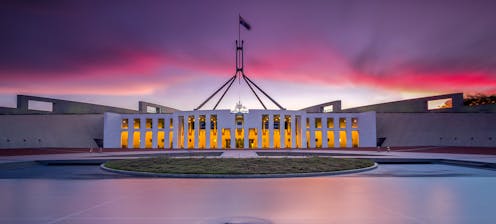Welcome to May 9 – the true Australia Day
- Written by Anna Howe, Honorary Professor, Department of Sociology, Macquarie University, Macquarie University

We missed out on a holiday for the king’s coronation.
Early next month we are about to get one for his birthday in most states of Australia, on a day that isn’t actually his birthday.
That holiday was Australia’s first, declared by NSW Governor Arthur Phillip in 1788 to mark the birthday of George III. It must have seemed as strange to the new arrivals as to the Australians on whose land they had arrived.
It didn’t mark their safe arrival, it didn’t mark the raising of the Union Jack on Australian shores and it didn’t mark the founding of Sydney. Nor did it acknowledge the first peoples already on the continent.
These days the king’s birthday is even less relevant than it was.
The king no longer has the power to enact laws governing Australia. That finished when his mother Queen Elizabeth signed the Australia Act 1986, which ended the ability of the United Kingdom to make laws with respect to Australian states and the ability of Australian states to take disputes to the UK Privy Council.
But hiding in plain sight, just a month before the king’s birthday holiday, is a date most of us have a much better reason to celebrate – it’s May 9, which this year also happens to be budget day.
May 9 is the real Australia Day
Australia’s constitution was proclaimed on January 1 1901, but only had full effect when our first federal parliament met on May 9 1901, in the Exhibition Building in Melbourne.
When the parliament moved to Canberra in 1927, the new temporary parliament house was again opened on May 9.
Six decades later, when the new and permanent parliament house was opened on Canberra’s Capital Hill in 1988, the date chosen was again May 9.
It is not simply these events that make May 9 the real Australia Day.
In his speech on May 9 1988, Prime Minister Bob Hawke said the new building would
become for our nation both the forum for our differences and the instrument of our unity – a building for all Australians, a parliament reflecting the diversity of our entire society and responding to the needs of the whole community.
And it has. In parliament, our local members and Senators take up issues that concern us and debate and resolve them. The legislation they have created ranges from the everyday to the extraordinary.
The 1918 Electoral Act required all electors to vote. The 1973 Medicare Act gave us the healthcare card we take for granted.
More exceptionally, the 2017 Marriage Amendment Act gave same-sex couples the right to marry, in accordance with the wishes of the majority of the population.
The 1967 referendum allowed the parliament to legislate for Indigenous Australians for the first time. If the Voice Referendum is passed, Indigenous Australians will get a constitutionally enshrined mechanism for making representations to it.
Our parliament is worth celebrating
What legitimates decisions made in Australia is that they come from a process that involves the Australian people, through the Australian parliament, rather than a structure outside Australia or beyond the ability of Australians to control.
We have changed the political complexion of the parliament many times, yet through it all the parliament has become more representative of us over time.
The first two women were elected in 1943. By 2022, we had 58 women in the House of Representatives, including 19 elected for the first time, and a female majority in the Senate.
The first Indigenous senator, Neville Bonner, was elected in 1971. By 2022, eight senators and three members of the House of Representatives identified as being Aboriginal or Torres Strait Islander.
Ten of our members of parliament are first-generation migrants, including government ministers Tanya Plibersek and Penny Wong. Among the children of immigrants is Prime Minister Anthony Albanese.
Read more: White, male and straight – how 30 years of Australia Day speeches leave most Australians out
I was born a British subject in 1945, in Sydney, to Australian-born parents. The 1948 Citizenship Act made me an Australian citizen alongside all British subjects living in Australia.
The Act also opened the way for “aliens” – those born outside the Commonwealth – to become naturalised Australian citizens. The king’s birthday can have little meaning for them or their locally born children.
Most migrants become citizens, and what has made this possible is an act of the Australian parliament.
How to make it happen
Making May 9 a public holiday is easy. It doesn’t require legislation and doesn’t require a referendum. January 26 was only proclaimed a national holiday in 1994.
May 9 has a much longer, more illustrious history. It is a date “made in Australia” and demonstrates our commitment to our democracy like no other day can.
By May 9 2026, our parliament will have been in place for 125 years. That makes 2026 a good year to become a republic. Should a referendum be successful, the first parliament of the Australian republic could meet on May 9 2026.
If it takes another year, the first parliament of the Australian republic could meet on the centenary of the opening of the first parliament house in Canberra, on May 9 2027.
I hope I live to celebrate that day. In the meantime, I’ll forego this year’s king’s birthday holiday and instead celebrate on May 9. The weather in most places should be okay for a barbecue, so why not join me, before it becomes official?
Source https://theconversation.com/welcome-to-may-9-the-true-australia-day-204555

